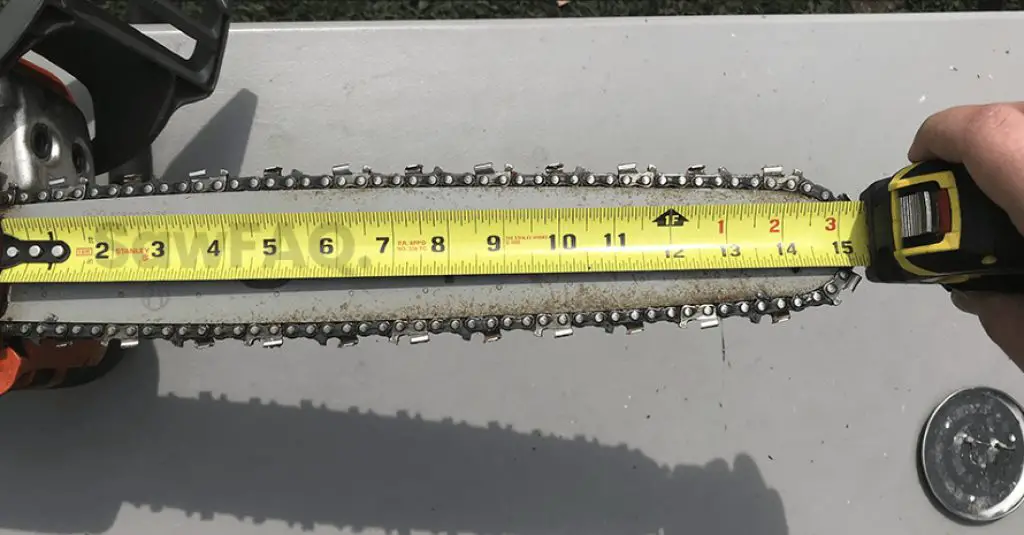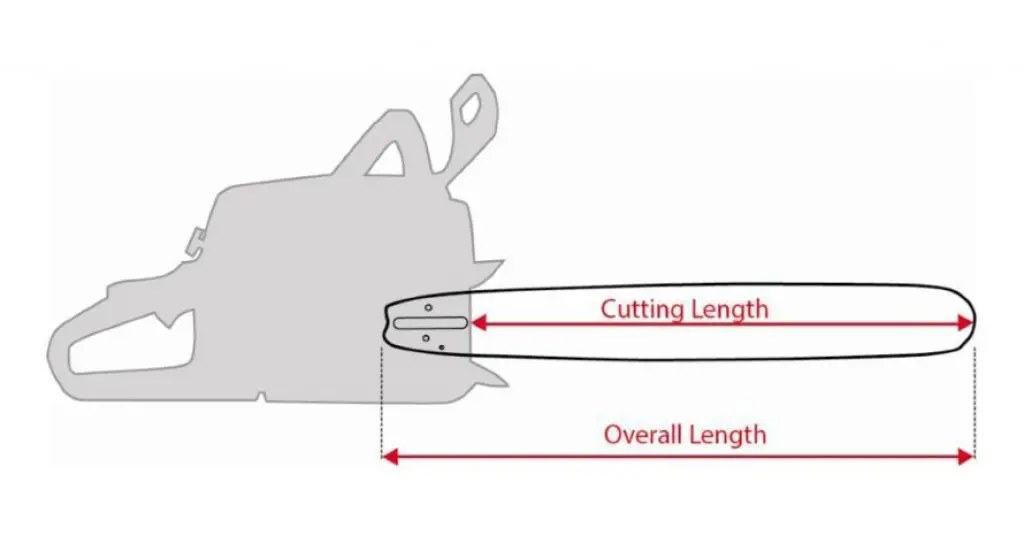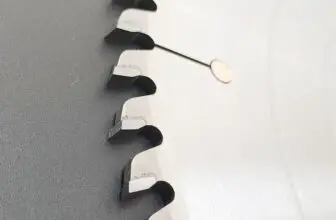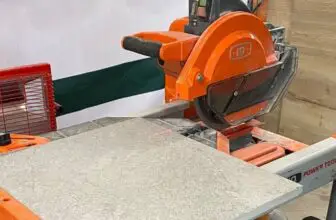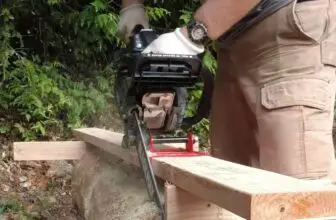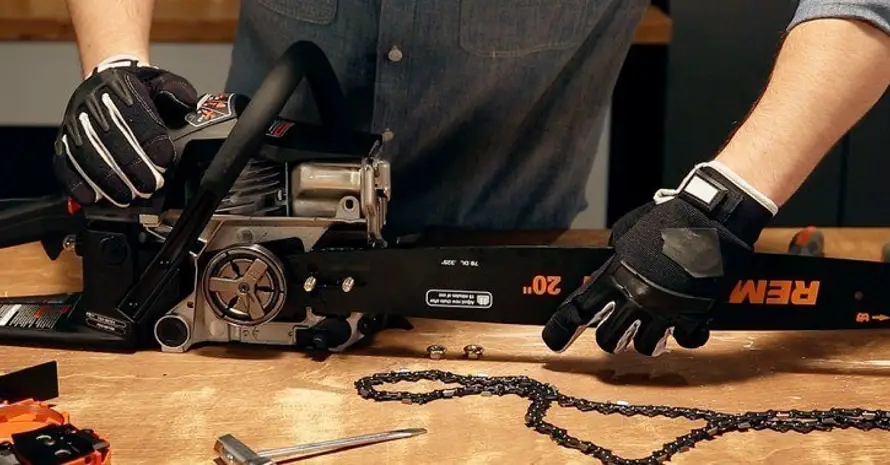
Are you wondering how to measure chainsaw bar length? Chances are you are looking for a different bar (blade) for your chainsaw. You are wondering if the bar you have will fit the new saw you are planning on buying. Or maybe you just purchased a new tool, and you are trying to figure out how to measure bar length.
One way or another, you are looking for the correct information to do this simple task. Well, you are in luck – this is an easy process to do.
How to Measure Chainsaw Bar Length Guide
Contents
This section will tell you how to measure chainsaw bar and chain correctly. Follow the steps, and you will not go wrong.
Effective cutting length
The easiest method of measuring is finding out the effective cutting length of the saw. Chainsaw bar length is measured from the tip of the blade to the point where the blade attaches to the chainsaw.
With the saw off, measure the length from the point where the bar is attached to the saw to the tip. If you got an uneven number, round it up to the next highest inch.
True length
The most accurate bar measurement is the true length. This method involves taking the chainsaw off the bar and measuring the blade from tip to tip. To measure this, you need to remove the blade and chain and stand the bar on a flat surface. This will give you the overall length.
Step 1: Remove Housing
First, you need to remove the chain tensioner housing. This will make it easier to take the chain off and will give you more room to stand the bar on a flat surface. To do this, you need to loosen the chain tensioner screw.
Once the screw is loose, use a flathead screwdriver to push the chain tensioner back. This will allow you to slide the housing off the blade.
Step 2: Remove chain
Once you have the housing off, you need to remove the chain. Loosen chain tensioner screw so that the teeth on the bar are no longer pinched in the tensioner. Pull the bar away from the engine and slowly rotate the blade so that the chain is no longer on it.
Step 3: Check the blade
Once you have removed the chain, you need to check the blade for damage. You can do this by looking at the teeth to see if they are bent, worn, nicked, or otherwise damaged. If you see damage like this, you need to replace the bar.
Step 4: Measure
Now that the blade is completely free of the chain, you need to place the blade on a flat surface. Then, you can use a tape measure or ruler to measure the length of the bar. Start at the tip of the blade and go all the way to the end. This will give you a measurement of the true length.
Step 5: Reinstall
After you order the correct length of the blade, you need to reinstall it. Reinstall the bar by taking the chain off and sliding the blade back onto the engine. Slide the housing back onto the blade and tighten the screw down to hold it in place.
Once you have the housing back on, you need to slide the chain back on the blade. Make sure the teeth are aligned with the tensioner.
Chainsaw Sizes and Their Uses
The following is a list of chainsaw bar lengths and their uses:
- 6 inch blade is the smallest bar available for home chainsaws. It is considered to be a good size for limbing but should only be used by an experienced climbing tree trimmer.
- 8-12 inches for basic tree trimming and cutting firewood. This size of bar is the most popular and is available on most gas and electric chainsaws. Remember that small saws shouldn’t be used to cut large trees.
- 14-16 inches is the most common blade length for most professional tree trimmers. It is used for bucking felled trees or trees that have already been limbed.
- 18 inches for lighter, smaller chainsaws. This is a good length for homeowners who only need to cut firewood or small trees.
- 20 inches is a good length for homeowners with a few acres of wooded land.
- 24 inches is a popular length and can be used for any residential use.
- 26 inches is for advanced users, such as experienced lumberjacks. This length is for chainsaws with high power. The greater length allows for heavier duty cutting, which can range from cutting wood to cutting metal pipes.
- 36 inches is for heavy-duty jobs, such as cutting down trees. This length is also popular for cutting firewood because it allows for fewer rest periods.
FAQ
Here are some questions that are frequently asked by people that are considering buying a chainsaw blade or that are having trouble finding the right chainsaw bar for their saw.
What size chainsaw do I need?
That depends on what you want to use it for. For example, 16-inch chainsaws are good for limbing and pruning. You’d need a bigger chainsaw if you’re planning on cutting up large trees or logs.
How to measure chainsaw chain length?
Chain size is measured in pitch (distance between the centre of one rivet hole to the next) and gauge (the thickness of the saw chain). The pitch is the distance between the center of one hole to the center of the hole opposite it.
The pitch is “measured” by placing a pair of calipers or a pitch gauge between the two holes and measuring the distance between the tips.
What if my chain length is slightly larger?
Exceeding the maximum length for a chainsaw bar will cause the chain to rub against the sides of the guides. This will wear down the chain and blade quickly. It will also cause a lot of vibration and a poor cut.
What is the best way to measure chainsaw bar?
One of the easiest ways to determine the right size is to measure from the tool’s front tip to the cutter that is closest to the body. This measurement is often called “cutting length” or “CL”.
What do the numbers on a chainsaw bar mean?
There are two numbers on a chainsaw blade (a 3/8″ bar is the standard size). The first number is the tooth pitch, or how far apart the teeth are spaced. The second number is the gauge, or how thick the steel is.
Final Word
As you can see, measuring the chainsaw bar is not that difficult. The above guide should help you out, but if you still have some questions, feel free to leave them in the comments section below.

